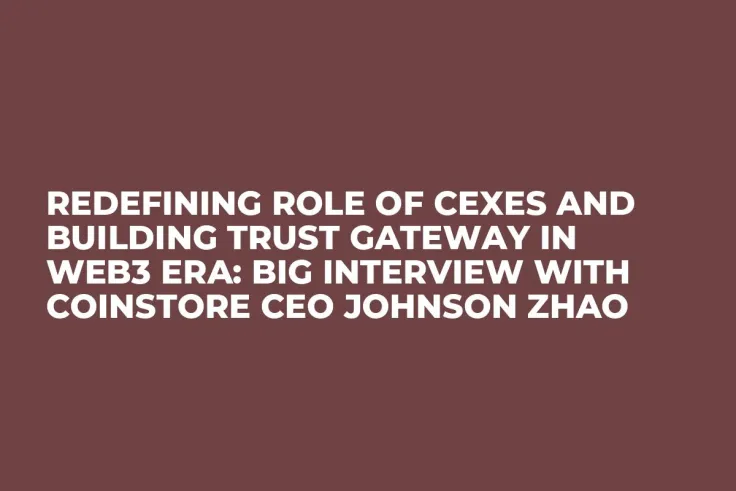
Disclaimer: The opinions expressed by our writers are their own and do not represent the views of U.Today. The financial and market information provided on U.Today is intended for informational purposes only. U.Today is not liable for any financial losses incurred while trading cryptocurrencies. Conduct your own research by contacting financial experts before making any investment decisions. We believe that all content is accurate as of the date of publication, but certain offers mentioned may no longer be available.
In 2025, as the global crypto industry undergoes a profound structural transformation, Coinstore, a tier-1 centralized crypto exchange, has officially launched its Brand 2.0 strategy — a redefinition of platform value, user connection and ecosystem trust.
This is not a simple visual refresh. It is a deep remapping of Coinstore’s strategic architecture. In the evolving convergence of CEXes and Web3, Coinstore’s new brand identity no longer just symbolizes functionality; it reflects commitment. It aims to become the trusted Web3 entry point for global users and a value partner throughout their digital asset journey.
In this exclusive interview, Coinstore CEO Johnson Zhao shares his insights into why the brand upgrade was necessary, what it signals about the state of the market, and how Coinstore plans to build for the next cycle.
U.Today: What macro forces in the crypto ecosystem created the strategic imperative for this brand transformation, and why is this the optimal timing window?
Johnson Zhao: We're witnessing a fundamental shift in crypto's value model. For a decade, competition centered on efficiency: lowest fees, fastest execution, most listings. That was the race everyone was running.
But the market has matured. Today's users aren't asking "what can I trade?" They're asking "who can I trust?" Whether institutional or retail, sophisticated or new, they want partners that align with their long-term success, not just transaction pipes.
This represents crypto's evolution from transactional to relationship-based. The timing is critical because we're at an inflection point where trust becomes the primary differentiator.
Brand 2.0 isn't just a rebrand. It's strategic repositioning around what we believe will be crypto's core competitive advantage: being a trusted ecosystem partner that delivers sustainable, long-term value.
U.T.: What are the foundational pillars of Brand 2.0, and how do they translate into tangible value propositions for different user segments?
J.Z.: This is a comprehensive transformation across three strategic dimensions.
First, our emotional identity: vibrant gradients and the refined positioning "One Touch to Crypto." This isn't just aesthetic, it's a promise that complex blockchain interactions should feel as intuitive as any consumer app.
Then, product experience: we're building the world's most trusted Web3 gateway. Users can seamlessly onboard, explore, and scale their digital asset journey through simplified interfaces and guided pathways.
Also, it’s about our strategic mission: to simplify access to the digital asset economy through intuitive, secure, and borderless experiences. This signals our evolution from a traditional exchange to a comprehensive Web3 companion.
Each layer reinforces the others, emotional identity builds trust, product experience delivers accessibility, and strategic positioning ensures we're built for Web3's long-term trajectory.
U.T.: What new user pathways and engagement mechanisms are you building to deliver on this full-lifecycle Web3 companion vision?
J.Z.: We’ve built out a framework called the “Four New” Strategy:
New Brand: Trust as infrastructure. We’ve launched transparency reporting, asset audit mechanisms, and global 24/7 support to make “long-term partner” more than a slogan.
New Markets: We’re expanding in Southeast Asia, LATAM, and Africa, not as speculative zones, but as local Web3 ecosystems. We support regional licensing, fiat channels, and decentralized product integrations.
New Alliances: We’ve upgraded Launchpad with AI-assisted project vetting, enabling three-way governance among teams, users, and platforms. It’s no longer just token launches, it’s lifecycle alignment.
New Rules: We view compliance as a growth strategy, not an obligation. Our on-chain custody and institutional-grade asset management tools aim to make regulation a source of user value, not cost.
U.T.: How do you plan to activate and scale the network effects required for successful ecosystem gateway adoption?
J.Z.: We've orchestrated a series of tangible initiatives to ensure users genuinely experience this transformation. First, we've partnered with leading industry players including OMDB, CINO, Axioma, Accumulate, Edubuk, Chiko, Barin Mineral Token, StrikeBit to launch a comprehensive brand upgrade celebration. This spans metaverse communities, live streaming interactions, and community AMAs, giving our global user base immediate exposure to our new brand identity and enhanced platform capabilities.
We're also preparing significant offline presence. At August's CoinFest conference, Coinstore will debut with our complete Brand 2.0 identity. This represents a critical showcase for demonstrating our transformation to both industry stakeholders and users.
The integrated online-offline approach ensures broader market exposure to Coinstore's substantial brand evolution. This is an ongoing process—we have additional market initiatives planned ahead.
U.T.: What fundamental shifts do you anticipate will reshape the Web3 landscape over the next 3-5 years, and how is Coinstore positioning for these changes?
J.Z.: We're positioned at a critical inflection point where crypto transitions from "wild growth" to "mature development." Based on our deep analysis of global markets, we anticipate three structural shifts over the next 3-5 years:
Regulatory Normalization: From Gray Zones to Mainstream Pathways More nations will establish clear crypto asset policy frameworks. This isn't industry constraint—it's a necessary evolution toward maturity. Regulatory clarity will drive two effects: dramatically raising platform entry barriers and eliminating non-compliant players, while creating substantial first-mover advantages and trust premiums for compliant platforms. We predict a significant consolidation where surviving platforms will be fewer but operate as institutional-grade "infrastructure providers."
User Base Transformation: From Crypto-Native Communities to Mass Market The real tipping point will be the mass influx of non-crypto-native users. These users won't learn complex technical concepts to access Web3—they expect experiences as simple, secure, and predictable as traditional financial products. This demands platforms evolve from "feature-driven" to "experience-driven" product philosophy, making underlying complexity completely transparent.
Value Capture Evolution As on-chain identity, reputation mechanisms, and governance tokens mature, Web3 platforms will evolve from simple "transaction facilitators" to "governance nodes within value networks." Future revenue models will extend beyond transaction fees to encompass ecosystem governance, data services, infrastructure operations, and other diversified income streams.
U.T.: How would you characterize the current market cycle, are we in a bear market, bull market, or something more nuanced, and what key indicators inform your assessment?
J.Z.: We're witnessing the transition from Web3's "first industrial cycle" to its "second industrial cycle."
The first cycle was driven by liquidity and narrative: from DeFi to NFTs, from GameFi to Memecoins. Its essence was rapid propagation and price discovery of financial assets, but structurally it was low-trust and low-delivery.
Now we're entering a value-driven long cycle: regulatory frameworks are emerging, projects face demands for substantive progress disclosure, and users no longer make decisions purely based on FOMO. This represents the industry's gradual shift toward engineering rigor, standardization, and institutionalization.
The industry is transitioning from explosive growth to sustainable evolution—this is the era of long-term thinking. Platforms lacking institutional resilience, compliance infrastructure, and community co-creation capabilities will struggle to survive until the next growth wave.
This isn't a bear market in the traditional sense. It's the industry maturing from speculation-driven to value-driven fundamentals. The platforms that understand this shift and build accordingly will emerge stronger when the next cycle accelerates.
U.T.: What role should a CEX play in the next Web3 era? What role does Coinstore want to play?
J.Z.: A CEX should not just be a bystander. It should become a builder of the value ecosystem.
We see three levels of responsibility:
- User level: Provide transparent, auditable data. Help users make informed, not emotional, decisions. Be a bridge between trust and access.
- Policy level: Work with regulators to shape frameworks that are both protective and enabling. We’ve launched regulatory pilots in UAE, Malaysia, and the UK.
- Ecosystem level: Actively collaborate with builders, developers, and DAO communities to support project sustainability. We want to be a “value amplifier,” not just a transaction venue.
Ultimately, we want Coinstore to become the first trusted touchpoint into the digital asset world — where every Web3 user can find clarity, confidence, and long-term growth.
U.T.: Coinstore has cultivated a distinctly understated approach to global expansion, prioritizing deep market penetration over high-profile marketing. What strategic advantages does this methodology create in today's competitive landscape?
J.Z.: We prefer to position ourselves as the Web3 equivalent of "Transsion" or "Kunlun Tech." These companies represent a distinctly Chinese approach to global expansion: deep market cultivation, product localization, and genuine local market understanding. They don't rely on media buzz or publicity—instead, they build formidable ecosystem moats through solid operations and precise user insights in seemingly peripheral markets. This aligns perfectly with Coinstore's strategy.
Our approach has always been clear: user-centric development with deep roots in the fastest-growing markets—Southeast Asia, Middle East, and Africa. We build robust trading infrastructure through product localization, compliance-first mindset, and long-term thinking.
We've always believed that truly valuable brands aren't defined by noise, but validated by time and users. Since inception, Coinstore has made "global deep cultivation" our core strategic direction, rather than chasing market hype or short-term exposure.
Our focus is systematic infrastructure building: compliance frameworks, product experience, local operations, and ecosystem integration. This work appears slow, heavy, and complex, but these elements form an exchange's true "moat"—determining whether you can survive market cycles.
In an environment of evolving global regulation and maturing user sophistication, only platforms that genuinely start with users and measure success over the long term will endure. The flashy players may capture headlines, but sustainable platforms capture trust and market share.
 Alex Dovbnya
Alex Dovbnya Arman Shirinyan
Arman Shirinyan Dan Burgin
Dan Burgin Caroline Amosun
Caroline Amosun